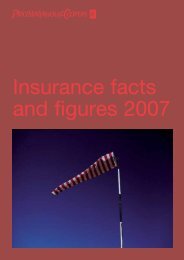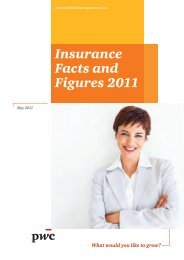Dataline A look at current financial reporting issues - PwC
Dataline A look at current financial reporting issues - PwC
Dataline A look at current financial reporting issues - PwC
You also want an ePaper? Increase the reach of your titles
YUMPU automatically turns print PDFs into web optimized ePapers that Google loves.
Topic Initial ED Revised ED <strong>PwC</strong> observ<strong>at</strong>ions<br />
within PP&E or<br />
investment property,<br />
as appropri<strong>at</strong>e, but<br />
separ<strong>at</strong>ely from<br />
assets th<strong>at</strong> the lessee<br />
does not lease.<br />
<strong>financial</strong> st<strong>at</strong>ements.<br />
The right-of-use asset<br />
would be classified in a<br />
manner consistent with<br />
classific<strong>at</strong>ion had the entity<br />
owned the underlying asset.<br />
For lessees, the changed profile of the balance sheet and rel<strong>at</strong>ed income<br />
st<strong>at</strong>ement effects could have implic<strong>at</strong>ions for st<strong>at</strong>e and local tax apportionment<br />
as well as franchise and property taxes. Multi-n<strong>at</strong>ional companies will also need<br />
to evalu<strong>at</strong>e the impact of the changes in rules on their intern<strong>at</strong>ional tax profile.<br />
There will be no<br />
clarific<strong>at</strong>ion of whether the<br />
right-of-use asset<br />
recognized by the lessee<br />
represents a tangible or<br />
intangible asset.<br />
Present<strong>at</strong>ion –<br />
Balance sheet<br />
for lessors<br />
A lessor applying the<br />
derecognition<br />
approach should<br />
present rights to<br />
receive lease<br />
payments separ<strong>at</strong>ely<br />
from other <strong>financial</strong><br />
assets and should<br />
present residual<br />
assets separ<strong>at</strong>ely<br />
within PP&E.<br />
Under the receivable and<br />
residual approach the lessor<br />
should either present the lease<br />
receivable and the residual<br />
asset:<br />
Separ<strong>at</strong>ely in the balance<br />
sheet, summing to a total to<br />
be called "lease assets," or<br />
Together in a single line<br />
item—lease assets—in the<br />
balance sheet, and<br />
separ<strong>at</strong>ely disclose those<br />
two amounts in the notes.<br />
The revised ED is not expected to require explan<strong>at</strong>ion of the underlying n<strong>at</strong>ure<br />
of the residual asset. The requirement to recognize accretion of the residual<br />
asset as interest income is consistent with a view th<strong>at</strong> the residual asset is a<br />
<strong>financial</strong> asset. However, the present<strong>at</strong>ion option and the requirement to apply a<br />
long-lived asset impairment, r<strong>at</strong>her than <strong>financial</strong> asset impairment, model may<br />
imply th<strong>at</strong> the residual asset should be viewed as non-<strong>financial</strong>.<br />
Present<strong>at</strong>ion would remain<br />
consistent with <strong>current</strong> practice<br />
for leases not classified under<br />
the receivable and residual<br />
approach.<br />
N<strong>at</strong>ional Professional Services Group | CFOdirect Network – www.cfodirect.pwc.com <strong>D<strong>at</strong>aline</strong> 33

















